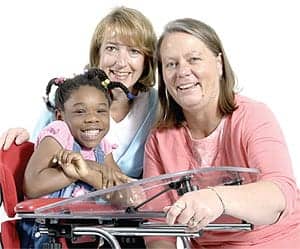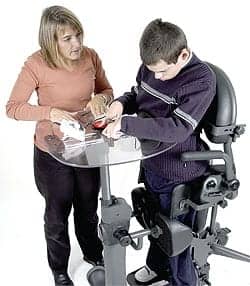
Mary Miles, PT, and Connie Senger, PTA, with Leonna, who has a traumatic brain injury.
Standing for kids with disabilities can sometimes feel like another task on a list of many. To make life easier for parents, therapists often suggest incorporating standing activities into the routines of the child’s day. Similarly, this can be done while the child attends school. Opportunities abound for how this can look in the school setting. This article spotlights some of my experiences working in a school district, including program settings and students attending mainstream programs.
Students of all ages and abilities can experience the opportunity to stand while at school without taking away from their academic or learning opportunities. Standing should be seen as a part of a student’s day, similar to the opportunities to sit in a chair or sit on the floor. How do you begin to incorporate these opportunities?
THE YOUNGEST STUDENTS
For our youngest learners, standing might be the opportunity to get out of their chair to stand by the sensory table to play with their peers in preschool. Many standers can accommodate this with open-front designs or removal of the tray for this activity. Standing can continue for gym games, playing tag in the gym with an adult or child helping the child move in some cases, or allowing the child to move himself if he has a mobile stander. Similarly, standers can be used for educational learning in these young students; time for computer or SMART Board interaction while up in the stander often helps these students to reach items more readily or more quickly than if they are in their chair or walker. The ability to be upright with peers from a young age helps kids (and teachers) to accept the stander as normal classroom or school equipment.
ELEMENTARY SCHOOL: OPTIONS ABOUND
As students move onto the elementary scene, standing is again easily incorporated into the curriculum. In the program for children with developmental and cognitive disabilities (DCD program), we have incorporated standing into the routines of our students twice a day to allow changes in their position in the morning and afternoon.
Students are seen standing during functional groups, perhaps working with another student if it is a cooking day to make a simple recipe on their stander tray. During paper-bag making groups, those with sensory needs might also be in the stander, working at the table to make homemade paper bags with water and screens and pressed paper.

For more information on this topic, read “The Need to Stand” and “The Rising” from previous issues.
We have also used standers for physical education classes; particularly helpful is the mobile-type stander, which allows the kids to move and interact with their peers in an upright position while also reaping the benefits of standing. It can also be useful to have stationary standers for volleyball, badminton, and other court or ball-type games, allowing the children to stand while enjoying free use of their hands to participate in playing with their peers.
Social groups and snack time can be additional times to schedule standing as part of that routine. For some students in the DCD program, we have discovered standing fits best into their day during academics; their minds become more alert and they are well supported in their trunk to engage in learning activities. Most standers can be fitted with a tray allowing pen-and-paper activities to be easily accomplished while standing.
OLDER STUDENTS: IN THE MAINSTREAM
You may be wondering how standing looks for the student who is engaged in a full day of mainstream academics. Standing can be incorporated into mainstream classes as readily as special education programs or preschool classrooms.
The older student may have more anxiety about standing in class with their peers, but many middle and high school students have the opportunity to take a study hall. In our district, we often schedule a study hall midway through a student’s day to allow a change in position, which also helps to alert their mind to finish out the day. Once up in the stander, with a little help to set up, students are still able to access computers, work on homework, and accomplish tasks in the same manner as typical students.
The important piece as the student becomes older is to ensure they understand the benefits of standing and help them to feel like they are a part of the decision-making process. Helping to decide when and where they will use their stander can empower the student.
WHY IS STANDING SO IMPORTANT TO INCORPORATE INTO THE SCHOOL DAY?
The benefits of standing are many. When it comes to standing at school, I often consider how many times a day a typical student gets to stand, move, or change their position. Recalling how tiring it is to sit through a seminar when we are used to changing positions as therapists, I find that it is important to give our students an opportunity to change, move, and wake up so they are ready to learn. Outside of alerting the body, the benefits of weight bearing and standing include increased bone density, improved circulation, and maintaining or improving flexibility.

Frankie likes to stand up and activate switches. Here PT Mary Miles helps him push the button and cool himself off with a fan.
Many of our students with physical disabilities spend a large portion of their day sitting in wheelchairs, which makes them susceptible to contracture development, which in turn can decrease their functional abilities. As adolescents with physical disabilities grow into adult-size bodies, it can become more difficult for those who care for them to transfer them safely, and continue to provide a safe daily standing program.
If we can begin at an early age incorporating standing into the routine of the school day, students will grow up maintaining their flexibility and functional ability to stand and transfer. Often, with their participation in a daily standing program, we can prevent the need for extra staff (and two-person lifts) in the schools because students are able to continue standing for transfer needs during their school day. I am not suggesting students shouldn’t be standing outside of their school day, but realistically with most hours spent in school, we need to be accountable for the educational outcomes during the school day.
A+ MERITS OF STANDING
Prolonged sitting or immobility is also associated with decreased circulation, and it can cause pressure sore development in some cases. Decreased mobility can lead to constipation (often associated with students with disabilities). Children and adolescents with physical disabilities need to spend time out of their wheelchairs to get pressure relief, allow increased circulation, and anecdotal evidence of improved bowel and bladder function.
Once standing routines are scheduled into the busy school day, we have found increased compliance with staff and students taking responsibility for their standing program. Physical therapists can take a back seat role if they have done the proper training and brainstorming to set up a program that fits smoothly into the routines of the school day.
Mary Miles, PT, DPT, is a pediatric physical therapist working for Independent School District 624 in White Bear Lake, Minn, servicing children up to 18 years old. For more information, contact .
For more information on this topic, visit www.rehabpub.com/, and www.rehabpub.com/





